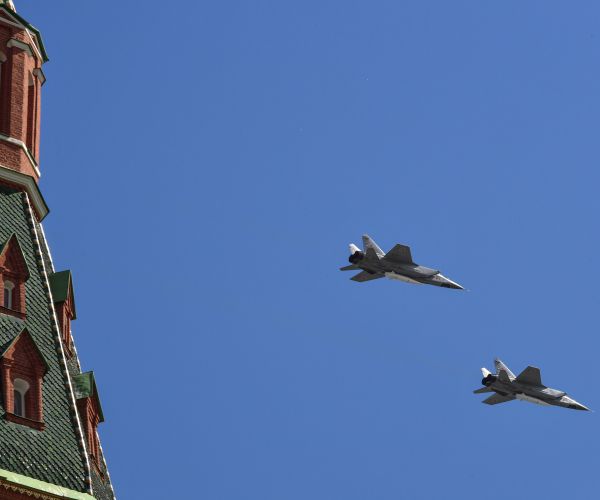Hypersonics: A New Tech Threat

(Yuri Kadobnov/AFP/Getty Images)
Six minutes.
It’s usually regarded as a meaningless amount of time most often relegated to the mundane. In six minutes we can floss and brush our teeth or take a quick shower, although it’s not enough time to boil an egg or cook a bowl of pasta.
However, today — because of the potential of hypersonic missiles — the technology may suddenly exist to bring about mass destruction in six minutes.
Over the last twenty years, Americans have lived through incredible technological advancements that have constructively affected the way we live. These advances have also dramatically changed industries like retail, media, publishing, and transportation, where business that were once brick and mortar giants are suddenly closed or struggling to barely exist. We champion and applaud the new technology that enriches our lives while we just as easily overlook the negative economic effects it’s had on a wide range of businesses.
We have yet to face a new technology that endangers our safety and well-being, but with the rapid development of the hypersonic missile, we suddenly face a looming military threat that can strongly impact the world as we know it. While nuclear weapons and the continual threat of terrorism are never overlooked, the hypersonic missile has been disregarded, at least budgetarily, for the time being.
“A hypersonic missile, with no payload, just its own kinetic energy, is powerful enough to take down an entire building,” said Bob Mercier, chief engineer for the high-speed systems directorate at the Air Force Research Laboratory, who spoke with me on the phone recently.
A hypersonic missile can carry nuclear warheads, a standard explosive payload, or rely merely on its own kinetic energy to deliver significant destruction. Missiles can travel in three speed ranges: subsonic, supersonic, and hypersonic. Subsonic missiles fly at less than the speed of sound, about 1,000 kilometers per hour. Supersonic missiles fly above Mach 1, about 1,000 to 5,000 km/hr. Hypersonic missiles can travel at 5,000 to 25,000 kilometers per hour, or one to five miles per second, which is between six and 25 times faster than modern airliners at altitudes ranging from 10 to 100 kilometers. This span of altitudes — until the last minutes of flight — make these missiles unpredictable as to their targets, creating myriad challenges to global security because their speed makes it extremely difficult to launch a counter attack.
“To every view of morals there are two sides: what is demanded by man; what is exacted by the conditions of life.”
— Robert Louis Stevenson
In a national address in February 2018, Russian President Vladimir Putin claimed to have developed a new generation of hypersonic missile that is impervious to Western defense systems. Although experts are skeptical that these missiles are close to operational, go dates as soon as 2023 are considered realistic and believe an aggressive, proactive strategy is necessary.
“The nation needs to do an awful amount of work defending against this capability because the threats are evolving very rapidly,” said Brad Tousley, DARPA Tactical Technology Office Director, according to darpa.mil and Aviation Week.
A recent Newsweek article quoted Vladimir Putin as saying, “I would like to tell those who have been trying to escalate the arms race for the past 15 years, to gain unilateral advantages over Russia, and to impose restrictions and sanctions… The attempt at curbing Russia has failed.”
Hypersonic weapons can be launched from the ground, aircraft, and from ships, and can reach a target from 1,000 kilometers in only a few minutes. Because of their speed and high-altitude capabilities, hypersonic missiles pose serious defensive vulnerabilities and can defeat even underground facilities. The combination of the missile’s speed, maneuverability, and altitude make it very difficult to defend against.
“We know hypersonic war fighting is here. We know we have got to get there, and we know we have to get some transition strategies to go forward,” says Col. Colin Tucker, military deputy for the U.S. Air Force deputy assistant secretary for science, technology, and engineering, according to Aviation Week.
Hypersonic technology has been in existence for decades but until recently, the development has not been particularly aggressive, based on the budgetary allotments. In 2012, the Air Force spent approximately $79 million on hypersonics and — according to the Air Force — requested over $292 million in the 2018 presidential budget for hypersonics S&T, including $90 million for prototypes. With both Russia and China aggressively pursuing this technology (as well as India and France), one must consider why this isn’t a higher budgetary priority?
“It’s a big problem for us. We have been kind of resting on our laurels,” said Leon McKinney, president of McKinney Associates and former executive director of the U.S. hypersonics industry team, according to Aviation Week. “The U.S. has been fighting wars and terrorism, so that is one of the reasons we have not seen a burst of capability developments. But it seems our adversaries are catching up.”
A recent article in Science Alert noted that the Chinese are in the process of building the world’s most powerful wind tunnel that will help to one day create hypersonic commercial travel. While the applications for hyper fast travel are exciting and can one day change air travel as we know it, a wind tunnel like this will be instrumental in the development of hypersonic weapons as well and seems to place China at the forefront of this technology.
DARPA Director Steven Walker said the agency is working on several projects, including two in partnership with the Air Force, to develop hypersonic engines and weapon prototypes. “It is very clear that China has a focus on hypersonics and is making it one of their national priorities,” Walker told Air Force Magazine in March 2018. Walker also spoke to foreignpolicy.com and said that China is making hypersonics a “national priority,” adding, “I think we need to do the same.”
Another important consideration is that lesser countries can develop this technology and then pose a serious threat to large countries with greater military power. France and India have made major progress in developing hypersonic technology, as have Japan and Australia. Clearly, a proactive approach is necessary in not only building the missiles but engaging in nonproliferation efforts as well. “We are still in the science and technology phase of development and demonstrations in hypersonics, so to compare it to an existing piece of weaponry, like the F-35 is difficult because the dollar values are so much different,” says Mercier. There is no doubt however, that these weapons will eventually be produced, and by more than one country. “You can’t project national power if you’re third in this race,” added Mr. Mercier.
Hypersonic technology also has applications other than weapons that can positively affect the global economy. If commercial airlines one day offer hypersonic travel, a trip to Japan that once took 20 hours could happen as fast as 3 to 4 hours each way. According to Robert Mercier, we could be only 15 to 20 years away from that technology. “Hypersonics will be a key enabler for all kinds of progress in the future. Things will eventually begin to look like science fact, not science fiction.”
Based on their long-range plans, it’s clear that hypersonics are a priority for Russia and China, and the United States of course remains a global superpower and is committed to staying there. However, investment in new technology continues to demonstratively change the way we live our daily lives — from communications to cars — and a significant, ongoing investment by America in hypersonics will ensure fruitful growth for our citizens and ongoing peace for years to come. The desire to develop and build hypersonics clearly exists, but we can’t move forward effectively without adjustments to our budgets, both military and societal.
China is clearly investing in the future, not just for national security, but for their entire society. Making large bets on new technology (big data and AI) are crucial to remaining a world power and we will have to make necessary tradeoffs (less conventional weapons for more tech) in our defense budget to insure these advances happen. America must make a choice to invest in the future rather than the past, but as federal budgets continue to grow more bloated, the greater stranglehold we place on technological progress. We need to pay as much attention to military technology as we do to the apps on our phones.
Share:
